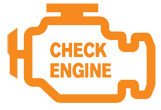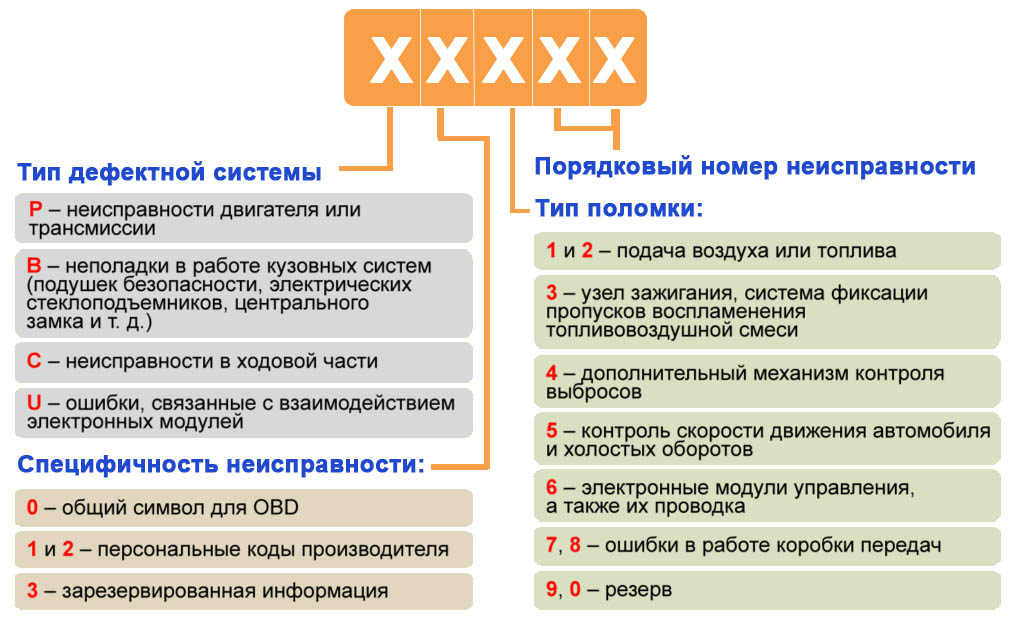Описание P1336 ошибки автомобиля Mitsubishi. В нашем справочнике имеется следующая информация:
На русском языке:
Датчик положения коленчатого вала
На английском языке:
Crankshaft Position Sensor
Выберите модель для возможности более детального просмотра информации по этой ошибке:
Ошибка работы двигателя или АКПП P1336 автомобиля Mitsubishi
В разных марках и моделях автомобилей одна и также ошибка может возникать как следствие неисправности абсолютно разных элементов.
Возможно будет интересно:
Если ошибка указывает на неверные параметры (высокие или низкие значения) какого нибудь из датчиков или анализаторов, то вероятней всего этот элемент исправен, а проблему надо искать так сказать «выше по течению», в элементах работу которых анализирует датчик или зонд.
Если ошибка указывает на постоянно открытый или закрытый клапан, то тут надо подойти к решению вопроса с умом, а не менять бездумно этот элемент.
Причин может быть несколько: клапан засорен, клапан заклинил, на клапан приходит неверный сигнал от других неисправных узлов.
| Code | Fault Location | Probable Cause |
|---|---|---|
| P1336 | P1336 – Crankshaft Position System Variation Not Learned (GM) (Buy Part On Amazon) |
We recommend Torque Pro
Manufacturer Specific Definitions for P1336
| Make | Fault Location |
|---|---|
| Acura | Crankshaft position (CKP) range/performance problem |
| Audi | Engine torque monitoring — control limit exceeded |
| Buick | Crankshaft position (CKP) sensor -variation not learned |
| Cadillac | Crankshaft position (CKP) sensor -variation not learned |
| Chevrolet | Crankshaft position (CKP) sensor -variation notlearned |
| Citroen | Crank / Cam Sensor Range / Performance |
| Daewoo | Crankshaft position (CKP) sensor – variation not learned |
| Dodge | No 5Vs To Throttle Position Sensor |
| Ford | Crankshaft Position Or Camshaft Position Sensor Input Signal Error |
| Gmc | Crankshaft position (CKP) sensor -variation not leamed |
| Gm | Crankshaft Position System Variation Not Learned |
| Honda | CSF Sensor Intermittent Interruption |
| Hyundai | #6 MF Signal Line Short |
| Infiniti | Crankshaft position (CKP) sensor- signal malfunction |
| Isuzu | Crankshaft position (CKP) sensor – signal variation |
| Jaguar | Crankshaft position (CKP) sensor — range/ performance |
| Kenworth | P1336 — High frequency corruption of crank signal during start up. |
| Lincoln | Camshaft position (CMP) sensor/crankshaft position (CKP) sensor -signal malfunction |
| Mazda | Crankshaft position (CKP) sensor/camshaft position (CMP) sensor – circuit range/ performance |
| Mercedes-Benz | Crankshaft position (CKP) sensor – signal |
| Mercury | Crankshaft position (CKP) sensor |
| Nissan | Crankshaft position (CKP) sensor 1 – rotor teeth damage |
| Oldsmobile | Crankshaft, position (CKP) sensor -variation not leamed |
| Peterbilt | P1336 — High frequency corruption of crank signal during start up. |
| Peugeot | Crank / Cam Sensor Range / Performance |
| Pontiac | Crankshaft position (CKP) sensor -variation not learned |
| Saturn | Crankshaft position (CKP) sensor -variation not leamed |
| Suzuki | 58x Crank Position Tooth Error Not Learned |
| Volvo | Starter request circuit – malfunction |
| Volkswagen | Engine torque monitoring — control limit exceeded |
Table of Contents
- What Does Code P1336 Mean?
- Where is the P1336 sensor located?
- What are the common causes of code P1336?
- What are the symptoms of code P1336?
- Get Help with P1336
What Does Code P1336 Mean?
OBD II fault code P1336 is a manufacturer specific code that is defined by carmakers General Motors and Isuzu as “Crankshaft Position System Variation Not Learned”, and is set on these applications when the PCM (Powertrain Control Module) detects that the system that monitors the position of the crankshaft has not “learned” the variations in the crankshaft position that are inherent in that system. Note that these variations include variations that occur as the result of normal deformations of the crankshaft.
Modern engines use crankshaft position sensors to monitor the position of the crankshaft relative to a reference point on the one hand, and to monitor variations in the crankshaft’s rate of rotation to detect misfires, on the other. In the first case, the crankshaft position sensor uses a gap between two teeth in a rotating reluctor ring to create a specific waveform that the PCM recognizes as a reference point, which is used to calculate ignition-timing and in some cases, fuel delivery strategies. In the second case, the PCM uses the time interval between successive “ON” and “OFF” signals created by the crankshaft position sensor and the rotating reluctor ring to calculate the engine’s rotational speed.
If engines were perfect machines, there would be no variations in the rate at which the crankshaft in any engine rotates, but the fact is that engines are not perfect, and therefore, significant variations in crankshafts’ rotational speed. Note that in many, if not most cases, variations in a crankshafts’ rotational speed are not the result of faults, defects, failures, or malfunctions in the engine and/or fuel management systems, but rather as the result of slight imperfections and shortcomings in an engine’s design and construction coupled with the tendency of some engine components to vibrate at certain frequencies when they are loaded.
As a practical matter though, each tooth on a reluctor ring acts as a kind of switch that makes and breaks a magnetic field in the crankshaft position sensor as it passes in front of the sensing element in the sensor. Each signal acts as a trigger that creates an ignition spark, and if all the components in an engine were perfectly balanced, the time interval between each pair of signals would always be the same, and the crankshaft would therefore rotate at a constant rate.
However, variations in manufacturing tolerances, slight imbalances between reciprocating parts, minute imbalances on rotating parts such as flywheels, clutch assemblies, torque converters, harmonic balancers, and even slight variations in combustion pressure between cylinders for whatever reason all have the potential to create slight variations in the rate at which the crankshaft rotates.
During the normal course of events, the harmonic balancer would absorb most of the naturally occurring variations in the crankshaft’s rotational speed, but unless a PCM is programmed to recognize small variations in a crankshaft’s rotational speed that occur as a natural consequence of normal engine operation, all variations would be interpreted as misfires. Therefore, to prevent this from happening, all PCM’s are programmed to ignore variations in the crankshaft’s rotational speed that are smaller than a specified value, which value is different for different engine types and designs.
In a fully functional system in which the PCM’s programming is working correctly, the PCM would only recognize variations in the crankshaft’s rotational speed that exceed the maximum allowable value, and only these variations would be recognized either as misfires, or power output imbalances between cylinders. However, it should be noted that this functionality depends on a piece of programming that could be thought of as a sub-system within the larger ignition control system, and to ensure that it operates correctly, the PCM monitors the health and status of this sub-system on a continuous basis.
There are many possible reasons why this particular sub-system may not be working as designed, but from an engine management perspective, the PCM is less concerned with the cause(s) of variations in the crankshaft’s rotational speed, than it is about the fact that it can no longer ignore the variations it had learned to ignore. Put in another way, the presence of code P1336 on GM and Isuzu applications means that the PCM now interprets all variations in the crankshaft’s rotational speed as misfires or power imbalances because it has lost its ability to distinguish between variations that exceed a maximum allowable threshold, and the variations it was programmed to ignore.
Essentially, the presence of code P1336 on GM and Isuzu applications means that the PCM has lost its ability to detect real misfires, as opposed to meaning that it has detected variations in the crankshaft’s rotational speed that exceed a maximum allowable threshold. From a diagnostic perspective this distinction is an important one, which is why when this sub-system fails (or is absent for whatever reason) the PCM will set code P1336 and illuminate a warning light first, before it sets any other misfire and/or power imbalance code(s).
Where is the P1336 sensor located?
The image above shows the location (arrowed) of the crankshaft angle sensor on a GM LS 1 engine. It should be noted that on most GM and Isuzu applications, the reluctor ring that works in conjunction with the crankshaft angle sensor is located inside the engine, which can make it very difficult to inspect the reluctor ring for damage or the presence of excessive accumulations of metal wear particles. However, it should also be noted that while defective crankshaft angle sensors and reluctor rings can cause code P1336 to set, the root causes of this code are many and varied. See the “Causes” section of this article for more details.
What are the common causes of code P1336?
SPECIAL NOTES: It should be noted that while removal and replacement of torque converters, flywheels/flex plates, clutch assemblies, harmonic balancers, and drive belts will generally not cause code P1336 to set, this is only true if the replacements parts are OEM or high-quality aftermarket parts.
However, in cases where the replacement parts are not equivalent to OEM parts in terms of fit, form, and function, imbalances on these parts could, and often do, produce variations in the crankshaft’s rotational speed that exceed one or more learned variation values, which will almost certainly cause code P1336 to be set.
Therefore, and to prevent this from happening, it is recommended that the prescribed “CASE” (Crankshaft Angle Sensor Error) relearning procedure be performed with a suitable scan tool every time a rotating component is removed or replaced. END OF SPECIAL NOTES.
Other possible causes of code P1336 could include one or more of the following-
- Failure to perform the prescribed “CASE” relearning procedure after having removed or replaced a rotating component
- Excessively worn and/or damaged timing components, including timing chains, timing sprockets, timing chain guides, and timing chain tensioning devices
- Improperly installed timing components
- Use of incorrect reluctor rings: note that while reluctor rings on a particular series of engines may look similar, they are different in respect of the positions of reference points that indicate the position of cylinder #1
- Low oil pressure, which could cause timing chain tensioning devices to lose their ability to keep timing chains properly tensioned, which could in turn, cause whipping or oscillating motions in timing chains, which could in its turn, produce significant cyclical variations on the crankshaft’s rotational speed
- Burnt, damaged, shorted, disconnected, or corroded wiring and/or connectors in the crankshaft angle sensors’ wiring harness
- The presence of almost any powertrain code has the potential to set code P1336 as an additional code to the primary code, but note that in these cases, P1336 will be set and stored after the primary code has been set and stored
- Defective crankshaft angle sensor and/or reluctor ring
- Use of some aftermarket crankshaft angle sensors
- Incorrectly or improperly programmed PCM
- Use of performance-oriented PCM programming, or the use of some brands of “piggy-back” chips to alter engine power deliver characteristics
- Failed or failing PCM, but note that since this a rare event, the fault must be sought elsewhere before any control module is replaced
What are the symptoms of code P1336?
Most common symptoms of code P1336 are much the same across affected GM and Isuzu applications, and could include one or more of the following-
- Stored trouble code and illuminated warning light
- One or more, (or multiple) additional codes may be present along with P1336
- Engine may stumble or hesitate upon acceleration
- Engine may misfire or run roughly at some, or all engine speeds
- Idling may be rough, erratic, or the idling speed may fluctuate somewhat
- Engine may start, but shut off again after a few seconds, but note that the time it runs before shutting off may not be consistent
- Engine may start and run perfectly until it is switched off, after which it may or may not start again
- In severe cases, the engine may not start at all, even though the cranking speed may not be affected
Help Us Help You
Please comment below describing your issue as well as the specifics of your vehicle (make, model, year, miles, and engine),
and one of our mechanics will respond as soon as possible. We appreciate a $9.99 donation via the payment button below.
Ошибка Р1336 у автомобиля Mitsubishi была обновлена 15:25. Определить ошибку в автомобиле Mitsubishi можно через диагностический прибор через соединение OBD2. Если у вас определена ошибка под номером Р1336 — тогда прочитайте ее обозначение согласно официальным техническим регламентам автомобиля Mitsubishi.

Код 1336 обозначает неполадки в работе контроллера коленвала. По каким-то причинам не было выполнено обучение регулятора, поэтому надо убедиться в его работоспособности и правильном подключении к электросети.
Приветствуется любая корректная, полезная и честная информация о ремонте ошибки Р1336 у автомобиля Mitsubishi.
Возможно Ваш отзыв сможет кому-то помочь!
Чтобы помочь вам в решении ошибки Р1336 и устранить её, опишите вашу ситуацию и комментарий ниже. Обязательно оставьте почтовый ящик, ответ и помощь придет в течение дня.

Илья Сергеевич Дорофеев |
Поддержка от автовладельцев Техник по диагностике автомобилей Mitsubishi Стаж: 18 лет Помогу решить любые вопросы возникшие с ошибками Р1336 по автомобилю Mitsubishi. Опишите подробно ситуацию форме ниже и я лично вам отвечу в ближайшее свободное время. Обязательно укажите номера ошибок, симптомы и конечно модель, двигатель и кузов. Для ответа мастера — поделитесь обязательно ссылкой с друзьями: |
Помощь и удаление ошибок у моделей Mitsubishi
ASX (АСХ); Canter (Кантер); Carisma (Каризма); Colt (Кольт); Diamante (Диамант) Galant (Галант); L200; Lancer 9, 10 (Лансер, Ланцер); Montero (Монтеро); X Pajero (Паджеро); Outlander (Аутлендер).
Автомобильный сканер для Mitsubishi
Ваш помощник в точном определении ошибки в том числе Р1336 и причины поломки. Дигностика любой модели Mitsubishi за 3 минуты, все показания бортового компьютера. Стирайте ошибки и выявляйте причину сами.
Примечание:
1. Для поиска других кодов неисправностей воспользуйтесь поисковой строкой. Введите свой код неисправности в поле поиска и отправьте поиск.
2. Информация, содержащаяся на этом сайте, представлена исключительно в информационных целях. Мы не несем ответственности за любые действия, предпринятые вами в отношении вашего автомобиля. Если у вас есть какие-либо сомнения относительно ремонта вашего автомобиля, обратитесь к своему техническому специалисту.
Поиск всех кодов ошибок на одном сайте. Расшифровка Кодов ошибок obd2 по маркам автомобилей.
Знайдено кодов ошибок: 1
Код ошибки:
Значение ошибки
Похожие причины кодов
Коды ошибок по маркам автомобилей
Примечание:
1. Для поиска других кодов неисправностей воспользуйтесь поисковой строкой. Введите свой код неисправности в поле поиска и отправьте поиск.
2. Информация, содержащаяся на этом сайте, представлена исключительно в информационных целях. Мы не несем ответственности за любые действия, предпринятые вами в отношении вашего автомобиля. Если у вас есть какие-либо сомнения относительно ремонта вашего автомобиля, обратитесь к своему техническому специалисту.
Из чего состоит ошибка
В пятизначных кодах первый знак обозначает принадлежность к системе, в которой обнаружена неисправность:
- Р — неполадки, зафиксированные в работе силового агрегата либо автоматической трансмиссии (АКПП);
- В — неисправности, связанные с функционированием кузовных систем — электрических стеклоподъемников, подушек безопасности Airbag (SRS), центрального замка и т. д.;
- С — коды ошибок в работе шасси или ходовой составляющей транспортного средства;
- U — неисправности, связанные с электрикой или электронным оборудованием, взаимодействием между управляющими модулями, цифровым интерфейсом.
Второй знак обозначает:
- 0 — общая цифра для всех OBD2 кодов;
- 1 или 2 — код производителя транспортного средства;
- 3 — резервая позиция.
Третий знак в комбинации неисправности указывает на тип поломки:
- 1 и 2 — сбои в функционировании систем подачи воздуха либо топлива;
- 3 — неисправности в работе системы зажигания;
- 4 — неполадки, связанные с функционированием систем вспомогательного контроля;
- 5 — сбои в работу элементов системы холостого хода;
- 6 — неполадки, зафиксированные в функционировании электронного блока управления автомобилем или его электролиниями;
- 7 и 8 — неисправности трансмиссионного агрегата.
Последние два знака обозначают порядковый номер неисправности.
Copyright © 2021. Коды ошибок OBD-II с расшифровкой на русском языке — возможные причины, описание и варианты по устранению ошибок.
Поиск •
Все последние сообщения •
Все последние темы •
Архив
Внимание новичкам! •
Регистрация •
Вход
P1336 ДПКВ
На страницу 1 2 След.
Магазины запчастей

 |
Все форумы » Brilliance |
| Автор | Сообщение | ||||||
|---|---|---|---|---|---|---|---|
|
asteps
Авто: Brilliance M2 (JunJie) Сообщения: 50
Регистрация: 08.01.2009 |
|
||||||
|
Отправить ЛС |
|||||||
|
Lvenysh
Авто: Brilliance M2 (JunJie) Сообщения: 243
Регистрация: 23.07.2008 |
|
||||||
|
Отправить ЛС |
|||||||
|
Мих
Авто: Мицубиси Аутлендер Сообщения: 10981
Регистрация: 01.02.2007 |
|
||||||
|
Отправить ЛС |
|||||||
|
asteps
Авто: Brilliance M2 (JunJie) Сообщения: 50
Регистрация: 08.01.2009 |
|
||||||
|
Отправить ЛС |
|||||||
|
АнтонЭМ
Откуда: Санкт-Петербург Сообщения: 32
Регистрация: 01.06.2011 |
|
||||||
|
Отправить ЛС |
|||||||
|
asteps
Авто: Brilliance M2 (JunJie) Сообщения: 50
Регистрация: 08.01.2009 |
|
||||||
|
Отправить ЛС |
|||||||
|
Александров
Авто: Brilliance M2 (JunJie) Сообщения: 228 Регистрация: 01.05.2010 Профиль |
|
||||||
|
Отправить ЛС |
|||||||
|
Gorynych
Авто: Great Wall Hover H3 L Сообщения: 14
Регистрация: 09.01.2011 |
|
||||||
|
Отправить ЛС |
|||||||
|
Александров
Авто: Brilliance M2 (JunJie) Сообщения: 228 Регистрация: 01.05.2010 Профиль |
|
||||||
|
Отправить ЛС |
|||||||
|
raidnew
Авто: Great Wall Safe Сообщения: 19
Регистрация: 10.08.2013 |
|
||||||
|
Отправить ЛС |
|||||||
|
Александров
Авто: Brilliance M2 (JunJie) Сообщения: 228 Регистрация: 01.05.2010 Профиль |
|
||||||
|
Отправить ЛС |
|||||||
|
Gorynych
Авто: Great Wall Hover H3 L Сообщения: 14
Регистрация: 09.01.2011 |
|
||||||
|
Отправить ЛС |
|||||||
|
Александров
Авто: Brilliance M2 (JunJie) Сообщения: 228 Регистрация: 01.05.2010 Профиль |
|
||||||
|
Отправить ЛС |
|||||||
|
Gorynych
Авто: Great Wall Hover H3 L Сообщения: 14
Регистрация: 09.01.2011 |
|
||||||
|
Отправить ЛС |
|||||||
|
Александров
Авто: Brilliance M2 (JunJie) Сообщения: 228 Регистрация: 01.05.2010 Профиль |
|
||||||
|
Отправить ЛС |
|||||||
| Предыдущая тема :: Следующая тема | |||||||
|
Все форумы » Brilliance
На страницу 1 2 След.
























